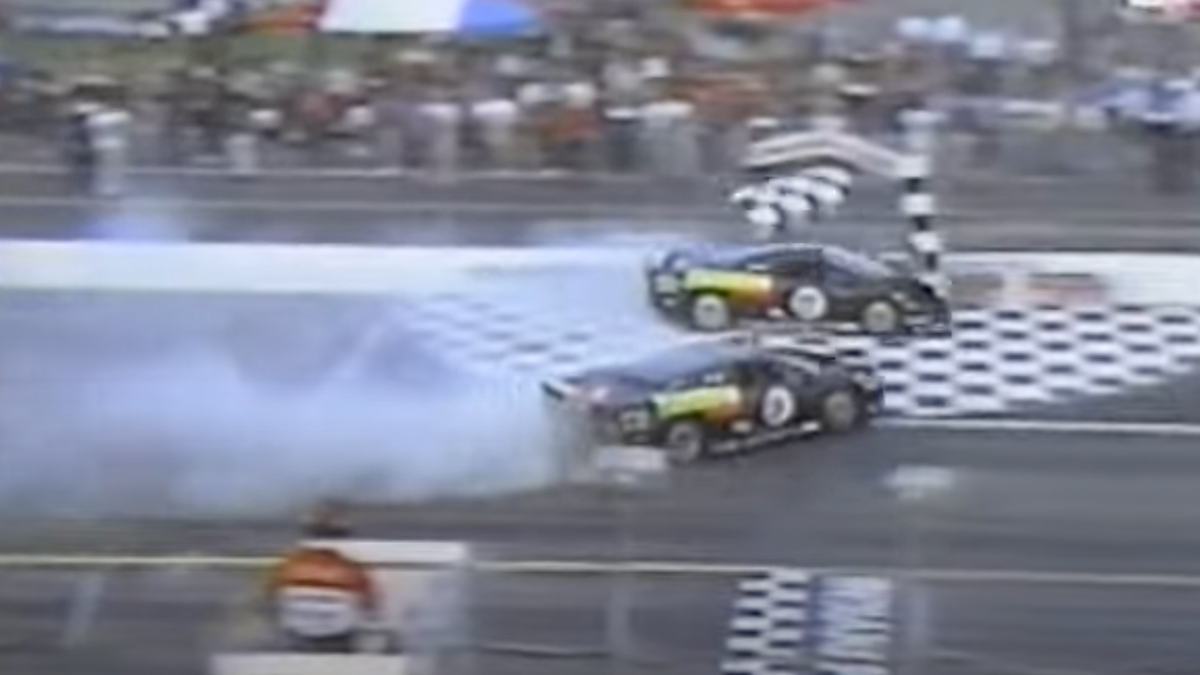Imagine a racing series that pitted your favorite retired drivers against one another on a tiny circuit behind the wheel of expensive, identically-prepared $1.3 million Jaguar XJ220 supercars. Imagine that you could tune in for a few weeks in the summer to watch those icons of sport beat, bang and destroy millions of dollars in equipment for a grand prize of $100,000. In 1993, that series actually existed, and it was called Fast Masters.
Fast Masters was essentially a made-for-TV racing product that lasted for six weeks in the summer of 1993. All six events took place at the same venue, the 0.686-mile Indianapolis Raceway Park roval, and all of the cars involved were Havoline-sponsored Tom Walkinshaw Racing-prepared Jaguar XJ220s that raced on high-performance Bridgestone Tires. To make things even wilder, the series was limited to drivers who were 50 or older, and the field on any given Saturday night could feature icons from IndyCar, Formula 1, NASCAR, or endurance racing — men like Paul Newman, Derek Bell, Henri Pescarolo, Rodger Ward, Parnelli Jones, and Bobby Unser.
Terry Lingner, one of the show’s producers, told Marshall Pruett that the primary goal for Fast Masters was to create compelling television over at ESPN.
“I was struck by the idea that the Bobby Allisons and the Pettys and the Pearsons of the world could still haul the mail,” he said. “And the idea that maybe [with] a stock car, you could do like seniors’ golf. Why not have a Saturday race for guys over 45?”
But you can’t just have a single race. Lingner initially considered a 10-race package but narrowed the number to something that could more easily captivate viewers and bring some locals out to the track. Next, all they needed were some cars.
I’ll let Tony Dowe, former Tom Walkinshaw Racing USA boss, explain that one:
Jaguar were pulling out of racing in North America, and there was still one year of a contract to go, and Tom [Walkinshaw] had gone to New York to meet with [Jaguar executives] Mike Dale and Bob Burton and so on, and he came onto me. He said, “Well, they’ll go another year. However, what they want is they want to be in the series with more relevancy to the product, and they also, it needs to have international appeal with drivers, and it needs to be on TV. Live TV. What can you do?”
Lingner, at the time, was considering a midget car racing series, but he couldn’t convince those senior drivers to get behind the wheel of something that was essentially a bare chassis with some wings tacked on. Dowe recalled telling Lingner, “Look, you know, mate. If you’ve got XJ220s, a supercar with all these drivers in, and Jaguar is helping and we put up a big prize fund, that’s got to be better than what you’re looking at with this midget car thing.”
Indianapolis Raceway Park made sense as a venue for plenty of reasons. First, it’s a really small circuit, so drivers wouldn’t be able to build up enough speed to really hurt themselves. Plus, the track was already equipped with TV camera cables to air Saturday Night Thunder, so it was easy to show up on race day and get all set up. TWR shipped 12 Jaguar XJ220s over to America, and Lingner and Dowe set to work preparing them to race at IRP.
The $100,000 prize purse convinced a slate of incredible drivers to sign up, but nabbing actor-turned-racer Paul Newman really helped set the show up for success.
The first event took place on Saturday, June 19 and featured three events: one 10-lap heat race on the oval, one 10-lap heat race on the roval, and one final race made up of six laps on the oval followed by six laps on the roval. Ten drivers were selected for the event, but only nine started because ol’ Gary Bettenhausen crashed so hard in practice that his car was wiped out.
By lap two of the first heat, the field was running three wide and crashing in absolutely spectacular fashion, resulting in several cars slamming right into victory lane.
And that was… pretty much the story of Fast Masters, which quickly earned the nickname Crash Masters. Every week, the series would recruit a handful of new drivers but fewer cars thanks to the extent of the damage they were undergoing.
The final championship race took place on Saturday, August 21. Ten drivers who performed well in the previous races advanced to the finals, where they took part in time trials to set the field for two eight-lap heat races. Odd qualifiers participated in the first heat, while even qualifiers entered the second. The top three finishers of each heat moved on to the final 12-lap event. Bobby Unser eventually took victory — and the $100,000 prize that came with it. That was more money than the winner of the Daytona 24 earned the following year.
As you can imagine, the wild, wonderful experiment that was Fast Masters didn’t make it for a second year. It was too damn expensive, Jaguar was done racing in America, and there was absolutely no way that any other automaker in their right mind would have subjected their machines to that kind of abuse — even if it came at the hands of some of motorsport’s most exceptional drivers. But it was a damn treat while it lasted, providing some of the wildest, wackiest racing in history.
To delve deeper into the series, check out this 30-minute video from Nascarman history, and check out the oral history of the series on Marshall Pruett’s podcast.

